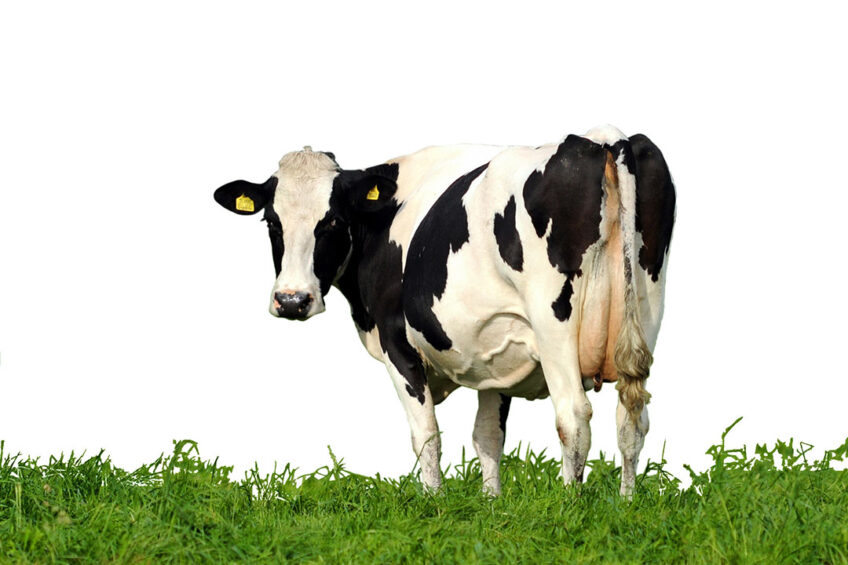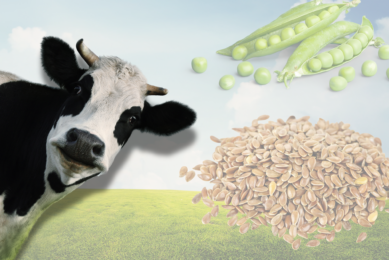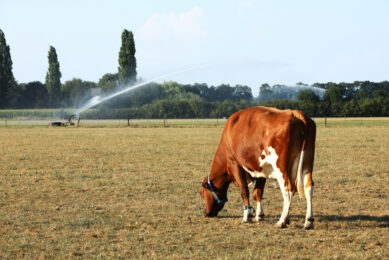Improving genomic prediction of methane emission

Methane emission is a heritable trait, which makes selection for lower emitting animals possible. Recent research with Danish Holstein dairy cattle shows the impact of a multi-trait approach to achieve high selection accuracy of lower methane-emitting animals.
Studies show that due to the limited number of cows with methane (CH4) records, the accuracies of genomic estimated breeding values (GEBV) are low. CH4 is a scarcely recorded trait, which means it would require a considerable number of cows with CH4 records in the reference population to accurately estimate GEBV. Researchers from Aarhus University carried out a study on the use of information of routinely recorded and highly correlated traits with CH4 to increase the accuracy of GEBV through a multi-trait (genomic) prediction approach.

The study
They focused their study on evaluating the accuracies of prediction of GEBV for CH4 by including or omitting CH4, energy-corrected milk (ECM) and body weight (BW), as well as genotypic information in multi-trait analyses across 2 methods: BLUP and single-step genomic BLUP (SSGBLUP). A total of 2,725 Danish Holstein cows with CH4 concentration in breath (14,125 records), BW (61,667 records) and ECM (61,610 records) were included in the analyses. Approximately 2,000 of these cows were genotyped. To find the best combination of traits in both the reference and validation populations, the following 5 scenarios were performed:
- Scenario 1: base scenario with only CH4 information
- Scenario 2: without CH4, but with information from BW, ECM or BW+ECM in reference population only
- Scenario 3: without CH4, but with information from BW, ECM or BW+ECM in both validation and reference populations
- Scenario 4: with CH4 information and BW, ECM or BW+ECM information in the reference population only
- Scenario 5: with CH4 information and BW, ECM or BW+ECM information in both validation and reference populations.
Figure 1 – Accuracies of prediction of genomic EBV for methane, averaged across 10 validation groups per sub-scenario for BLUP and single-step genomic BLUP (SSGBLUP). CH4 = methane concentration, OR = only reference, VR = validation + reference.

Consistency of predictor traits
To determine the benefit of including genotypic information in the prediction of the EBV and the consistency of the predictor traits across methods, 2 methods were tested:
- the BLUP, which used pedigree-derived additive genetic relationships to estimate an EBV for each animal in the pedigree, and
- the SSGBLUP, which allowed the addition of phenotypic information of non-genotyped animals into the genomic BLUP method by combining in a single step the genomic relationship matrix (GRM) with the pedigree relationship matrix into a new relationship matrix used to obtain the GEBV.
The researchers found that the average accuracy of GEBV for CH4 in the base scenario was 0.32 for the BLUP method and 0.42 for the SSGBLUP method. Comparing across multi-trait scenarios, the accuracy ranged from 0.10 to 0.72 for the BLUP method and from 0.12 to 0.75 for the SSGBLUP method. They concluded that multi-trait prediction performs similarly (or consistently) across the 2 methods and on average better than the single-trait scenario.
Prediction accuracy of GEBV
“Multiple-trait genomic prediction using routinely recorded BW and ECM leads to higher prediction accuracies than traditional single-trait genomic prediction for CH4. Including information on ECM increases the accuracy of GEBV for CH4 by up to 61%, whereas adding information on both traits (BW and ECM) increases the accuracy by up to 90%,” remarked the researchers. On the other hand, scenarios that did not include CH4 in the reference population had the lowest correlations (0.17–0.33) with single-trait CH4 GEBV (base scenario), and scenarios with CH4 in the reference population had the highest correlations (0.41–0.81). Thus, failure to include CH4 in future reference populations results in predicted CH4 GEBV, which cannot be used in practical selection. This means recording CH4 in more animals is a priority.
Which predictor trait is better?
Across sub-scenarios it was found that adding information on ECM better improved the accuracy of prediction of CH4 compared with adding BW. This was attributed to the relatively higher genetic correlation of ECM to CH4 compared to BW. It was clear that the magnitude of genetic correlations between the traits is the key factor determining the increase in accuracy. The 2 traits were reported as being good predictor traits for CH4. In addition, it was also observed that sub-scenarios with BW and ECM information in both reference and validation populations had higher prediction accuracies than the scenarios having the 2 traits on the reference population only.

Feasibility of multi-trait scenarios
Based on the accuracies obtained in this study across scenarios, three scenarios (scenario 3, 4, and 5) stood out.
Scenario 3
In this scenario without CH4, all the genetic variation of CH4 comes from ECM and BW, implying that a reduction in CH4 will in practice come from selecting smaller animals that produce less milk, which is counterintuitive to the aim of profitable dairy production – making the scenario not ideal.
Scenario 4
Conversely, scenario 4 with CH4 information and predictor traits included only in the reference population has the full genetic variation of CH4, including the fraction that is not solely explained by ECM and BW. “In principle, in scenario 4 with CH4 information included, using all traits in a selection index can achieve selection for lower emitting animals when increasing or maintaining milk production (i.e. improved methane intensity [CH4/L of ECM]). This scenario is the most ideal multi-trait combination since it is the most closely aligned to genomic selection schemes in practice and has the highest correlations (0.72–0.81) with the base scenario,” said the scientists.
Scenario 5
It is interesting to note that scenario 5, which has CH4 information and predictor traits (ECM and BW) in both the reference and validation populations, achieved the highest prediction accuracies. However, because GEBV are usually predicted for young animals before they have their own phenotypes, scenario 5 is not closely aligned with genomic selection schemes in practice. The researchers suggested that this scenario could be important when trying to predict CH4 in second or later lactation cows (with ECM and BW information available).
Concluding remarks
This study demonstrated that a multi-trait genomic prediction leads to higher prediction accuracy than traditional single-trait genomic prediction, particularly when predictor traits are highly genetically correlated with the goal trait. It can be concluded that the most feasible multi-trait scenario in terms of feasibility when predicting CH4 for young animals is the scenario with CH4, ECM and BW information in the reference population. This scenario also proved to be the one most genetically correlated with the base scenario. Although the scenario which has CH4 information and predictor traits (ECM and BW) in both the reference and validation populations achieved the highest prediction accuracies, the researchers think it more suitable when predicting CH4 in second or later lactation cows (with ECM and BW information available).
This article is based on the original article by Manzanilla-Pech C.I.V., D. Gordo, G.F. Difford, P. Lovendahl and J. Lassen. 2020. Multitrait genomic prediction of methane emissions in Danish Holstein cattle, Journal of Dairy Science Vol 103, 2020. https://doi.org/10.3168/jds.2019-17857.
Join 13,000+ subscribers
Subscribe to our newsletter to stay updated about all the need-to-know content in the dairy sector, two times a week.










